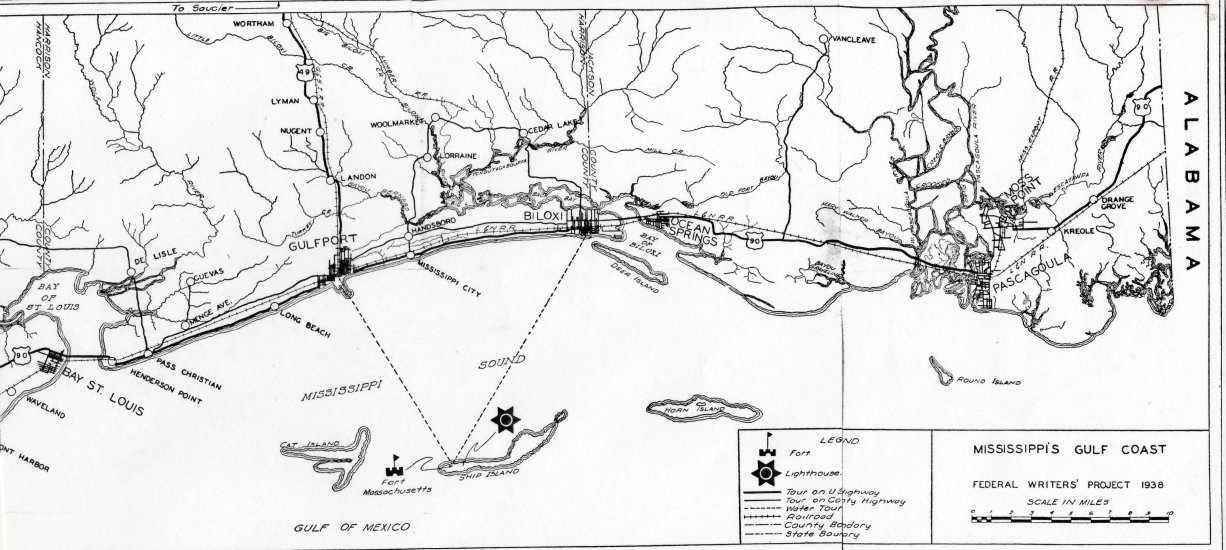
WOOLMARKET
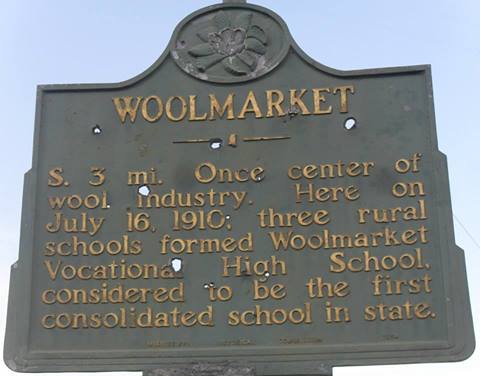

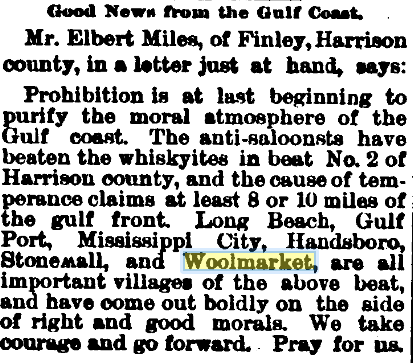
THOMAS WILLIAM GRAYSON (1825-1904)
Thomas William Grayson was born at Paulding, Jasper County, Mississippi on July 18, 1825. His father, Samuel Grayson, a Virginia native was a pioneer settler of Central Mississippi. The elder Grayson was a land surveyor and was an organizer of Jasper County. For fourteen years, Thomas Grayson served the people of Jasper County as the Clerk of the Chancery and Circuit Courts. After the Civil War in which he served with the Mississippi Volunteers 16th Regiment, Company F, Thomas W. Grayson and his wife, Ann Hyde (1832-1906), who he had married in 1847, settled at Shubuta. In Clark County, Grayson was engaged in the mercantile business.
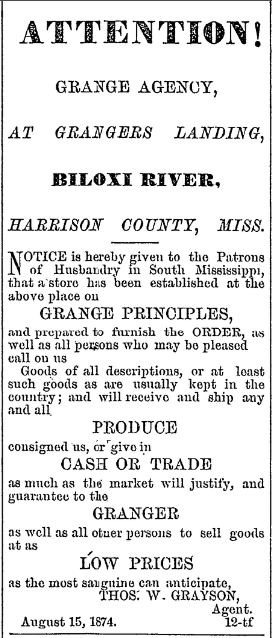
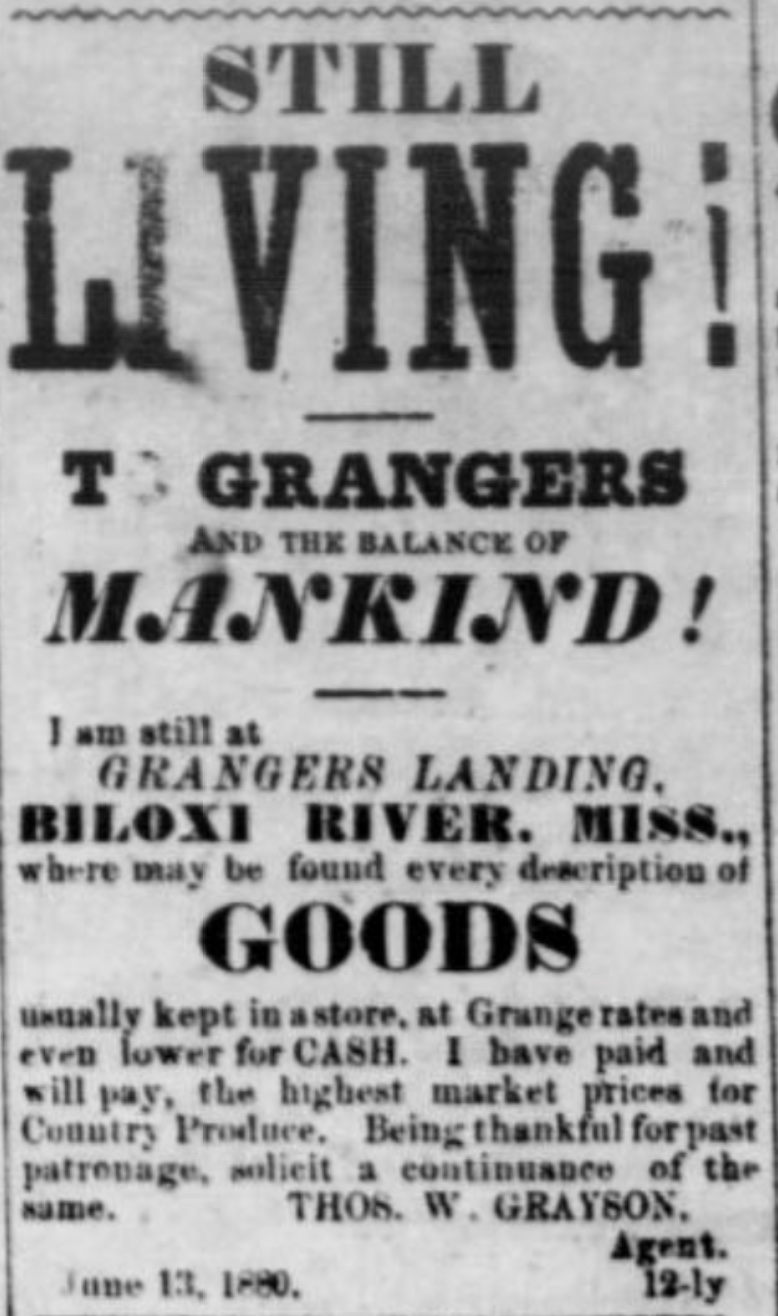
[The Handsboro Democrat, July 1, 1876, p. 4]
The Graysons moved to Ocean Springs in 1872. They remained here for two years and then relocated to Stonewall, now Woolmarket, in Harrison County. Grayson was a merchant there until 1881, when he moved back to Ocean Springs. His brother, George Grayson, had settled at Stonewall when the saw millers and woodcutters were actively exploiting the virgin, longleaf, yellow pine forest after the Civil War. George Grayson, himself a merchant, sold his store to Captain Joseph Stiglets. Stiglets deepened the lagoon to the Biloxi River and created a landing for his five coastal schooners. This site became known as Stiglet's Landing.
At Ocean Springs in January 1882, Thomas W. Grayson bought the home of Dr. David M. Dunlap (1803-1882+).(1) The property had two-hundred twenty feet on Washington Avenue south from Desoto and ran west to Jackson Avenue. Grayson had slightly over three acres in the heart of town. Barber and realtor, Edwin Martin Westbrook (1858-1913), would acquire a portion of this property later.(JXCO, Ms. Land Deed Bk. 5, pp. 615-616)
Thomas W. Grayson became a Justice of the Peace and notary. He served as Mayor of Ocean Springs in the term 1897-1898. At the time of his demise on March 4, 1904, he was Justice of the Peace for Beat Four. E.W Illing (1870-1947) was elected to his vacated office. Loren H. Whitney wrote the following after the death of Judge Grayson: "Suppose the whole world of people were like him. What then! There would be no more locking of doors at night. There would be no more jails or penitentiaries. The world would be transformed. Young men of Ocean Springs, study Judge Grayson's life and follow it, for it is worthy of all honor and praise.”
Judge Grayson was a Methodist and high-ranking Mason. He was a Mason for over fifty years. Thomas W. Grayson and Ann Hyde had thirteen children. The following are currently known: Lillian Grayson (1862-1892) married D.D. Cowan (1850-1929); Mrs. F. (Mary) Sandoz (d. 1915) of Mobile; Mrs. W.L. Owen of Alexandria, Louisiana; Walton G. Grayson (1870-1947); George W. Grayson (1870-1943) married Mamie Pol (1873-1951); Ella Grayson (b. 1875); Deliah Grayson (1885-married Clement G. Lang; Sallie Grayson (b. 1889) married John C. Orrell; and Thomas W. Grayson Jr.
Judge Grayson's corporal remains were interred at the Evergreen Cemetery in Ocean Springs, Mississippi. Mrs. Grayson died in early January 1906.(The Pascagoula Democrat-Star, January 12, 1906, p. 3)
REFERENCES:
Regina Hines Ellison, Ocean Springs 1892 (Second Edition), (Lewis Printing Services: Pascagoula-1991), p. 45.
Mississippi Gulf Coast Yesterday & Today (1699-1939), Federal Writers Project in Mississippi Works Progress Administration, (Gulfport Printing Company:Gulfport-1939), p. 136.
The Biloxi Herald, "Necrological", March 5, 1904, p. 1.
The Daily Herald, "Long Illness Is Fatal To Mrs. Geo. W. Grayson At Biloxi", November 19, 1951, p. 8.
The Pascagoula Democratic-Star, "Local News", October 12, 1883, p. 3.
The Pascagoula Democratic-Star, "T.W. Grayson", March 12, 1904, p. 4.
The Pascagoula Democratic-Star, "Ann Hyde Grayson", January 12, 1906, p. 3.
The Progress, "Thomas W. Grayson", March 12, 1904, p. 4.
The Progress, "Honor Judge Grayson", March 12, 1904, p. 1.
US Census - Jackson County, Mississippi (1900)
SCHOOLS

SHEEP and WOOL
A local industry long forgotten, but still in the distant memory of those born around 1920, is that of range animals. Cattle and sheep once roamed the savannas and forests of Harrison and Jackson County foraging on the native grasses. Several families in the St. Martin and Latimer communities north of Fort Bayou were especially well known for sheep husbandry. Some of these clans were the Basque, Krohn, Lamey, Seymour, Lemien, Eglin, Havens, Letort, and Ramsay families. The people living north of Ocean Springs in the piney woods were primarily subsistence farmers. They raised corn and hay to feed their cattle and hogs, had vegetable gardens, and supplemented their incomes through charcoal burning, lumber, and the wool from sheep. It was common for a farmer to own as many as a thousand sheep. In fact, the wealth of farm and country people was determined by their peers from the number of sheep that they possessed.
Sheep were generally never enclosed in pastures. The range was open to everyone and the stock animals of each owner mixed together. This necessitated marks and brands to differentiate ownership of the animals. From the Books of Stock Marks and Brands at the Jackson County Archives in Pascagoula, it can be ascertained the brands and marks of many individual animal owners. For example, in August 1919, Mary Doyle Krohn registered her brand as a V on the right hip of the animal. The brand and mark were valid for cattle, sheep, hogs, and goats.
In the spring on an appointed day, the stock owners had a "round up". On horseback, they drove the free ranging sheep to a common meeting point called the "parting pens". Here all the sheep were put into one pen and the lambs separated from them. The ewes were then placed in a pen with the lambs. When the lamb recognized its mother, the two were caught and the lamb given the owners mark and put into the pen of the owner. The individual flocks were then driven to the farm of each owner and shorn of their wool.
Flocks of sheep generally grew slowly as frigid winters took its toll. Many lambs died in the spring from exposure after birth. When turpentine stills were active in the area, the dogs of the turpentine workers roaming the forest, as well as wild hogs ate many young sheep. Eagles were troublesome to the farmers until they were nearly hunted to extinction. The wool produced in coastal Mississippi was classified as "Lake" wool. It brought a higher price than wool produced in counties further north as manufacturers considered it the very best.
Septuagenarian, Bernard Basque, resided on the family farm north of Fort Bayou, shared some of his childhood experiences concerning sheep husbandry. He remembers well the spring when the ewes gave birth to a lamb. Twins were rare. The lamb remained with its dam for about six months. Merino rams were bought in Texas for breeding purposes.
After shearing the sheep with manual shears, their wool was packed for market. A man would stand in a tall burlap bag and compress the wool by hand. When complete the wool bales would weigh two-three hundred pounds. In the early days, the wool was sent to Ocean Springs by wagon when the Davis Brothers were still active in the business. By the 1930s, merchant, Cliff Dees (1886-1963), at Vancleave, was the area wool broker.
Bernard Basque recalls to well the day his father, Joseph Basque (1892-1978), drove two thousand head of sheep to the farm of Albert White located north of Vancleave. He walked the entire distance herding the stray animals. Bernard relates that there were no "chuck wagons" on these sheep drives. Their family mark was "under square, under slope".
The Basque family had several uses for their sheep besides the commercial wool. The mutton was often eaten as a stew, baked, or fried. When a new baby was born into the family, the hide of a freshly slain sheep was stretched and dried. This sheepskin functioned as comfortable bedding for the youngster. Mrs. Basque and other women would card the wool into 4" x 6" squares called "batts". The batts were sewn between two layers of cloth and a warm quilt was created for bedding.
Colonial days
The history of sheep and wool in this area cannot be traced to the early Colonial years. In April 1699, when d'Iberville (1661-1706) landed at present day Ocean Springs to build Fort Maurepas, he recorded in his journal the following: "my longboat brought from the cows that belong to Surgere and me. We brought them from France. All those I got in St. Domingue (Haiti) died, three on board the Francois, one on the Marain, and four on the island where they had been placed (Ship Island?). Most people say it is the cold weather, although it has not been cold".
A few days later, the Frenchmen brought hogs and a bull to Fort Maurepas. No sheep are mentioned.
William R. Stuart
It is not known with great certainty when the first sheep were brought into Jackson County. As early as 1878, Colonel W.R. Stuart (1821-1894) was raising merino sheep at Ocean Springs. He also shipped pecans to Melbourne, Australia in 1890. Stuart had retired to Ocean Springs from New Orleans. On November 22, 1878, Stuart advertised his stock in The Pascagoula Democrat-Star as follows:
FOR SALE
PURE MERINO SHEEP
25 ewes, 2 years old in April to lamb 15 January to 15 February by a $200 imported Spanish buck.
10 pure merino bucks, 2 years old in April. My
connections with Colonel Cockrell of Tennessee, the great
breeder of pure merino sheep, enables me to fill orders at
all times from his large flock as well as my own.
W.R. Stuart-Ocean Springs, Mississippi
In July 1879, Colonel W.R. Stuart vended some of his Merino sheep to various Coast and regional stockmen. Alfred E. Lewis acquired three; Meyer, Weiss and Company of New Orleans bought six; A.A. Ulman, the proprietor of a wool factory at Bay St. Louis, got two; H.M. Duke of Scooba purchased one fine buck; and A.G. Ward of Mobile acquired two. Mr. Ulman believed that introduction of the Merino breed into the local flocks would improve the quality and quantity of the wool.(The Pascagoula Democrat-Star, July 7, 1879, p. 3)
In July 1879, Colonel Aldridge of Grenada, Mississippi drove four hundred sheep into northern Jackson County. It was anticipated that more stockmen would locate here to raise sheep.(The Pascagoula Democrat-Star, July 11, 1897, p. 3)
Woolmarket
Ocean Springs being the nearest railhead became a regional center for the buying and shipping of raw wool from the ranchers north of Fort Bayou. Woolmarket on the Biloxi River assumed this role at Harrison County. The coastal schooner was the vehicle for transport at that riverine village in Harrison County.
In 1882, the family of Thomas W. Grayson (1825-1904) came to Ocean Springs from the Woolmarket area. Grayson operated a mercantile store on the Biloxi River in the SW/4 of Section 32, T6S-R9W. This site later became known as Stiglet's Landing when Joseph M. Stiglets (1852-1924) purchased it from Dr. David M. Dunlap (1803-1884+) in November 1884.
Thomas W. Grayson is believed to have given the name "Wool Market" to the area since sheep and wool production prospered in the neighborhood. Grayson served the people of Ocean Springs as its fourth mayor (1897-1898). He was also Justice of the Peace here. His son-in-law, D.D. Cowan (1850-1929), was the first mayor of Ocean Springs (1893-1895) and also Superintendent of Education for Jackson County (1896-1905).
Back Bay Bridge
In July 1898, a writer for The Biloxi Herald publicized the need for a free bridge across the Back Bay of Biloxi to present day D'Iberville (called Back Bay at this time). He felt that the trade from this area was being diverted from Biloxi to other cities. As an example of this he related the following: Take the item of wool alone (which is grown beyond the bay), about $12,500 worth has been marketed at Ocean Springs this year and while this city could not hope to secure all the wool trade, there is not the least doubt but a large portion of that crop would be marketed in this city. There are many other products, which it is unnecessary to enumerate at this time, that would be marketed here had we such a bridge across the bay. (The Biloxi Herald, July 23, 1898, p. 2.)
The people of Back Bay (D'Iberville) got their wooden bridge to Biloxi in August 1901. It replaced an intermittent ferry system, which had been in established by the Board of Police of Harrison County in August 1843. Coincendentally, the first bridge to span Fort Bayou was dedicated in December 1901, replacing the Franco-Earle-Carver ferry which connected Ocean Springs to the wool country.
Wool marketing
In late May and June of 1891, nearly 63,000 pounds of wool were vended at Ocean Springs by local wool farmers, as compared to about 49,000 pounds in 1890. The Davis Brothers were acquiring large lots of wool for $.24 per pound while smaller lots were bought for a penny or two less. Last year prices were better. Wool growing is the best paying rural investment.(The Biloxi Herald, June 27, 1891, p. 1 and The Pascagoula Democrat-Star, June 12, 1891, p. 2)
The Davis Brothers, who operated a large mercantile store on Washington Avenue, were the leading brokers of wool at Ocean Springs. As early as 1891, George W. Davis (1842-1914) and Elias S. Davis (1859-1925) were purchasing wool from local farmers. When the shearing season closed in June of 1892, they had shipped over 60,000 pounds for which they paid about $14,000 ($.23 per pound).
In June 1895, New Orleans brokers paid local stockmen at Ocean Springs about .$13 per pound for over 30,000 pounds of Jackson-Harrison County wool.(The Biloxi Herald, June 15, 1895)
Sardin G. Ramsay vended 6000 pounds of wool to the Davis Brothers at Ocean Springs at the rate of $.15 per pound.(The Pascagoula Democrat-Star, June 4. 1897, p. 3)
H. Piser & Company of Mobile acquired over 50,000 pounds of Jackson County wool through the Davis Brothers, their local agent. The price was 19 1/2 cents per pound.(The Pascagoula Democrat-Star, July 7, 1899, p. 3)
Nine hundred head of sheep driven to Ocean Springs from the Vancleave ranches of H.C. Havens, Thomas E. Ramsay, and George W. Tootle. They were shipped to W.L. Bramblett in three railcars to Paris, Kentucky.(The Pascagoula-Democrat-Star, May 18, 1900, p. 3)
The Ocean Springs News reported the following wool marketing activity at Ocean Springs:
In June 1909, the Davis Brothers of Ocean Springs shipped about 1200 pounds of wool to the H. Piser & Co. of Mobile. They expected about 20,000 pounds to be marketed in the next week and consigned to the Mobile firm. This was the remainder of the remarkable wool purchase made by H. Piser & Co. sometime ago at the top notch price of 31 1/2 cents per pound.
In late August 1910, L.M. McClure & Company paid local stockmen 21 ½ cents per pound for their wool.
On September 22, 1910, the Metzger Brothers of Mobile bought 18,000 pounds of wool for 21 1/2 cents per pound. During the past three weeks nearly 40,000 pounds of wool were sold at Ocean Springs. Sardin Ramsay, one of Jackson Counties most substantial farmers and sheep owners, was in town to market his wool, probably the 18,000 pounds. L.M. McClure & Co. were local agents for Metzger Brothers. Sardin G. Ramsay (1837-1920) was a farmer and large landowner. The Ramsay tract consisted of several thousand acres of land in southeast quadrant of T6S-R7W. It was located southeast of the present day intersection of Highway 57 and the Gautier-Vancleave Road.
In late June 1912, wool growers from the country surrounding Ocean Springs brought over 70,000 pounds of their fleecy cut to town for shipment on the L&N Railroad to New Orleans, Mobile, and eastern manufacturing centers. Considered an average year, principal buyers, Metzker Brothers and Piser & Company of Mobile and William Vokel & Company of New Orleans, paid growers about $11,000 for their harvest.(The Daily Herald, June 27, 1912, p. 8)
In July 1915, the Ocean Springs district sold 32,000 pounds of wool at $.32 per pound. In 1914, the selling price was 21 to 25 cents per pound. As a result of the flush prices, several wool producers bought automobiles. Jackson County sheep owners produced 49,000 pounds of wool in 1915.(The Ocean Springs News, July 8, 1915, p. 1)
H.D. Money (1869-1936), who was the proprietor of the Rose farm north of Fort bayou, was also a proponent of sheep raising. Colonel Money had fruit and pecan orchards on his large farm. In September 1915, Money reported to The Ocean Springs News that his experience with sheep raising, although on a small scale, was very profitable. He related the following about his experiences: The fertilizer benefits they did those orchards is almost unbelievable. From scanty and unsatisfactory appearance, the trees put on a deep and healthy green. The nut yield is large. The sheep found abundant to eat-nothing was planted there-only the natural grass supported them. In keeping the weeds down, they saved me the expense of cultivating as well.
During the final years of World War I (1914-1918), the price of wool and mutton again increased dramatically. By October 1917, the price of wool reached $.60 per pound nearly doubling pre-War prices. Mutton cost the consumer $.17 per pound at this time. These inflated prices caused speculators to seek immediate investments in the sheep industry because of its high profit potential.
October 1917-Two hundred sixty head of sheep were shipped to Fort Worth, Texas by land owners north of Fort Bayou. Price was $3-$4 per head.
December 1917-The Southern Pine Association met at New Orleans to discuss the possibility of the large sheep flocks of the Western ranges relocating to the cut-over and timbered pine lands of the South. The western ranchers were restricted by recent homesteading of public lands there. These wool growers were seeking grazing lands for their large operations.
Newton Jones
At Ocean Springs, Newton Jones, a native of Columbus, Ohio, who came here in 1913, and bought Field Lodge, the home of Mary Florence Field at East Beach for $15,000, was one of these entrepreneurs who attempted to take advantage of the wool boom of the late War years. Mrs. Field was living at Nice, France when she sold her thirty-three acre estate to Jones. Here on the Cote d'Azur in 1914, she met Chevalier Scovel, the great tenor. They married and resided in Paris at the Villa Spontini. Field Lodge burned in the 1960s. In October 1917, Newton Jones bought 1200 acres in the northwest Latimer area from Anna Orrell and the heirs of Christopher Columbus Orrell (1832-1906), a turpentine operator and native of North Carolina, who settled here from Alabama. Here in Sections 21, 27, and 28 of T5S-R9W, he founded the Jackson County Sheep Ranch. The sheep ranch of Jones was located primarily in Harrison County straddling the Jackson County line about twelve miles north of Ocean Springs. It was fenced. In order to stock his ranch, Jones received a shipment of two hundred sheep from Bayou Sara, Louisiana in October 1917. Only one animal died in the relocation effort. The animals were driven from the L&N depot at Ocean Springs to his rural sheep ranch. In an October 1917, interview with The Jackson County Times, Newton Jones said: Sheep suffer from the lack of attention just like a growing crop, and for the best results to follow, one has to give them attention, or the enterprise becomes a failure.
In addition, Newton Jones said "that the average sheep grown in this territory weighed but 40 pounds at maturity, whereas lambs attained that size in the west in four months. This difference is the result of neglect on the part of those engaged in raising sheep, and they can be produced here of equal value to those in the west". He planned to demonstrate that they could. At the time during the Fall of 1917, a son of Newton Jones, Sergeant La Berne Jones, was serving in the Ohio artillery camped at Montgomery, Alabama. Newton Jones had a partner in the Jackson County Sheep ranch. He was Dr. Fitch who also came here from Ohio. Fitch officed in the Farmers and Merchants State Bank Building. He replaced Dr. Henry B. Powell (1867-1949) who went to Camp Shelby with the 139th Field Artillery as a Captain in the Medical Corps. After the War in April 1921, they sold their Latimer area sheep ranch to Forrest Short of Circleville, Ohio. Newton Jones also sold Field Lodge to Mr. Short at the same time, and apparently left the area. He and his wife, Gertrude Jones, probably returned to Ohio. The following reports were gleaned from The Jackson County Times to illustrate wool and sheep activity in the area from 1917 to 1927:
June 1919-A big wool sale of over 75,000 pounds at $.58 per pound was made in the area.
May 1924-Joe Basque (1892-1978) who lived north of Ocean Springs shipped 1000 head of sheep to Ohio. The price was $3.00 per head.
June 1924-Two carloads of wool were sold to a Mobile broker for $.40 per pound. The market had just dropped below this price.
June 1925-W.H. Westfall (1874-1939) and other merchants in the Vancleave area handled over 23,000 pounds of wool which was marketed at Ocean Springs at an average price of $.50 per pound. J.C. Harvey of Mobile bought the entire shipment.
June 1926-A quarantine order stopped movement of sheep in nine Mississippi counties, including Jackson. Sheep scabies, a communicable disease caused by mites, was the problem. Only dipped and disease free animals could be shipped. Several carloads of sheep were dispatched from Ocean Springs via dipping the vats at Hattiesburg. Mrs. Mary Doyle Krohn (1860-1944), former postmistress at Latimer and widow of Fred Krohn (1859-1918), sold 679 sheep to northern interest at $3.00 per head.
August 1927-During the past six weeks, Mr. R.J. Sously of Ocean Springs shipped over 6000 head of sheep to various parts of Kentucky, Tennessee, and Missouri. 2000 head were from the Krohn farm across Fort Bayou.
The decline of commercial sheep raising north of Fort Bayou can be traced to the passage of Chapter 263-House Bill No. 91 by the Mississippi legislature in 1926. The stock law was passed to prevent all live stock (cattle, horses, mules, jacks, jennets, sheep, goats, and hogs) from running at large upon open or unfenced lands. Animals were restricted to a safe enclosure. The statue also sought to prevent the spread of Texas fever ticks. In 1930, Bonnett v. Brown (No. 28288) tested the stock law in the Supreme Court of Mississippi. The original suit had been filed at George County.
Another crushing blow to sheep husbandry in the area was the 1934 screw worm epidemic. It did serious damage to regional flocks and almost destroyed the sheep industry at Jackson County.
Sheep are still raised in Jackson County today albeit their numbers are small. Now, wool fetches about $1.92 per pound as compared to $.50 per pound seventy years ago. In a comparable time period, land values in the outback Fort Bayou region have soared from $4.00 per acre to upwards of $1,000 per acre. The moral-raise land not sheep.
REFERENCES:
Ray L. Bellande, "Stiglets Landing", (unpublished essay), August 1995, p. 1.
Regina Hines Ellison, Ocean Springs, 1892, 2nd Edition, (Lewis Printing Services: Pascagoula, Mississippi-1991), p. 45, p. 55, and p. 59..
Facts About The Gulf Coast of Harrison County, Mississippi, (Reprint-Harrison County Publishing Company Ltd.-Gulfport, Mississippi-1985), pp. 13-14.
General Laws of the State of Mississippi, Chapter 263, (Tucker Printing House: Jackson, Mississippi-1926, pp. 374-375.
Jackson County WPA, p. 308.
Southern Reporter, "Bonnett v. Brown" (No. 28288), (West Publishing Company: St. Paul, Minnesota-1930), pp. 427- 429.
Jackson County, Ms. Record of Marks and Brands Book 2, pp. 12-13.
Minute of the Board of Police of Harrison County, Mississippi, Book 1, p. 42.
Journals
The Biloxi Herald, "A Bridge Needed", July 23, 1898, p. 2.
The Biloxi Herald, “Ocean Springs”, June 27, 1891.
The Biloxi Herald, "Ocean Springs", November 8, 1890, p. 4.
-------------------, "Ocean Springs", June 25, 1892, p. 1.
-------------------, February 21, 1899, p. 8.
The Daily Herald, “Lot Of Wool Sold In Ocean Springs”, June 27, 1912, p. 8
The Jackson County Times, "Local News Interest", June 30, 1917.
--------------------, "Jones Sheep Ranch Attracts Attention", October 6, 1917, p. 5.
--------------------, "Local News Interest", October 3, 1917.
--------------------, "Local News Interest", October 20, 1917.
--------------------, "Local News Interest", November 3, 1917.
--------------------, "Western Sheep Owners May Bring Flocks To South Mississippi", December 15, 1917, p. 1.
--------------------, Local and Personal, June 28, 1919.
--------------------, Local and Personal, May 31, 1924.
--------------------, "Farmers market two carloads of wool at Ocean Springs", June 28, 1924.
--------------------, Local and Personal, June 13, 1925.
--------------------, "Shipments of Sheep Stopped by Quarantine", June 5, 1926, p. 1.
--------------------, "Local and Personal", August 6, 1927.
The Ocean Springs News, "Local News", June 5, 1909.
The Ocean Springs News, “Local News”, August 20, 1910.
------------------, "Local News", September 24, 1910.
------------------, "Wool Shippers Want Autos", July 8, 1915, p. 1.
------------------, "Hundred Per Cent Profit", September 30, 1915, p. 1.
The Pascagoula Democrat-Star, "Sheep raising near the Gulf Coast", August 2, 1878, p. 1.
The Pascagoula-Democrat Star, "W.R. Stuart advertisment", November 22, 1878, p. 4.
The Pascagoula Democrat-Star, “Ocean Springs Items”, July 11, 1879.
The Pascagoula Democrat-Star, “Ocean Springs News”, June 12, 1891.
The Pascagoula Democrat-Star, “Ocean Springs Locals”, June 4, 1897.
The Pascagoula Democrat-Star, “Ocean Springs Locals”, May 18, 1900.
The Pascagoula Democrat-Star, "New Bridge Across Fort Bayou Opened", December 13, 1901.
Personal Communication:
Bernard Basque-March 1996 and July 1996.
Wool brokers
As early as 1881, Robert W. Lewis (1858-1886) of Ocean Springs was brokering wool for the William Mehle Company of New Orleans. (The Pascagoula Democrat-Star, April 22, 1881, p. 3)
Mr. Lewis was the son of Alfred E. Lewis (1812-1885) and Ann R. Farrington (1821-1901) of the Lewis Sha Plantation at West Pascagoula (Gautier). He married Mathilde L. Staples (1858-1928+), the daughter of Solomon G. Staples (1817-pre 1874) and Adeline A. Terrell (1829-1902) of St. Tammany Paris, Louisiana and Pass Christian, Mississippi. They were the parents of Ora M. Lewis Davis (1880-1911+), Lillian? Lewis (b. 1882), and Robert W. Lewis Jr. (1886-1904).
By 1892, the Davis Brothers at Ocean Springs, were purchasing wool from local farmers. When the shearing season ended in June 1892, they had shipped over 60,000 pounds of wool for which they paid about $.23 per pound. (The Pasacagoula Democrat-Star, June 1892) J.M. Breeland (1847-1903), a well-known sheep raiser in the region, shipped a car load of wool to Metzger Brothers of Mobile in October 1896. (The Pascagoula Democrat-Star, October 9, 1896)
By 1911, more than 40,000 pounds of wool were sold at Ocean Springs by sheep owners, who lived within a twenty-five mile radius of the town. Farmers received about $.18 per pound for their wool. Mobile brokers represented at the sale were H. Piser & Company and Metzker Brothers while Wm. E. Vouchel & Son came from New Orleans. (The Ocean Springs News, June 17, 1911, p. 1)
Demand for wool and mutton increased dramatically during WW I (1914-1918), as more than the entire wool production of America was utilized to make clothing for the US Army. (The Jackson County Times, January 12, 1918, p. 1) With this huge requisition for wool, the market price soared to $.58 per pound by the shearing season of June1919. Over 75,000 pounds of wool were sold by area farmers at Ocean Springs. (The Jackson County Times, June 28, 1919, p. )
After WW I, the demand for wool slowed and the price dropped accordingly. In June 1925, W.H. Westfall (1874-1939) and other merchants at Vancleave handled over 23,000 pounds of wool. It was marketed at Ocean Springs to J.C. Harvey of Mobile who paid an average price of $.50 per pound. (The Jackson County Times, June 13, 1925)
The decline of commercial sheep production in the piney woods section can be traced to the passage of Chapter 263-House Bill No. 91 by the Mississippi State legislature in 1926. This law was approved to prevent all livestock (cattle, horses, mules, jacks, jennets, sheep, goats, and hogs) from grazing at large upon the open range or unfenced lands. Stock animals were restricted to safe enclosure. The statute also sought to prevent the spread of Texas fever ticks. (General Laws of the State of Mississippi, 1926, pp. 374-374) In 1930, Bennett v. Brown (Case No. 28,288) tested the stock law in the Mississippi Supreme Court. The original cause had been filed at George County. (Southern Reporter, 1930, pp. 427-429)
Open range
In April 1932, the rural precincts of Jackson County voted to change the State stock law and allow an open range for stock animals outside of cities. The vote was 635 to 131 in favor of abrogation with approximately 50% of the eligible voters going to the polls. (The Daily Herald, April 5, 1932, p. 2)
US POSTMASTERS
William J. Johnston-December 1889
Mary Kittrell-June 1891
Eleanor M. Meyers- July 1893
Clara Cox- February 1899
Walter H. Cox-May 1899
James A. Calhoun-November 1907
Discontinued-April 1914
- Printer-friendly version
- 3426 views